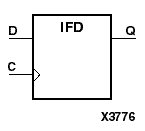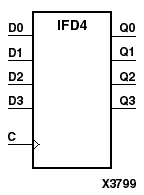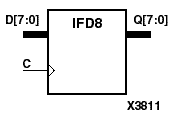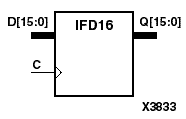| Element | XC3000 | XC4000E | XC4000X | XC5200 | XC9000 | Spartan | SpartanXL | Virtex |
|---|---|---|---|---|---|---|---|---|
| IFD | Primitive | Macro | Macro | Macro | Macro | Macro | Macro | Macro |
| IFD4, IFD8, IFD16 | Macro | Macro | Macro | Macro | Macro | Macro | Macro | Macro |




The IFD D-type flip-flop is contained in an input/output block (IOB), except for XC5200 and XC9000. The input (D) of the flip-flop is connected to an IPAD or an IOPAD (without using an IBUF). The D input provides data input for the flip-flop, which synchronizes data entering the chip. The data on input D is loaded into the flip-flop during the Low-to-High clock (C) transition and appears at the output (Q). The clock input can be driven by internal logic or through another external pin.
The flip-flops are asynchronously cleared with Low outputs when power is applied. For CPLDs, the power-on condition can be simulated by applying a High-level pulse on the PRLD global net. FPGAs simulate power-on when global reset (GR) or global set/reset (GSR) is active. GR for XC3000 is active-Low. GR for XC5200 and GSR (XC4000, Spartans, Virtex) default to active-High but can be inverted by adding an inverter in front of the GR/GSR input of the STARTUP or STARTUP_VIRTEX symbol.
For information on legal IFD, IFD_1, ILD, and ILD_1 combinations, refer to the “ILD, 4, 8, 16” section.
| Inputs | Outputs | |
|---|---|---|
| D | C | Q |
| 0 | 0 | |
| 1 | 1 | |
Figure 6.4 IFD Implementation XC4000, Spartans |
Figure 6.5 IFD Implementation XC5200, Virtex |
Figure 6.6 IFD Implementation XC9000 |
Figure 6.7 IFD8 Implementation XC3000, XC4000, XC5200, XC9000, Spartans, Virtex |